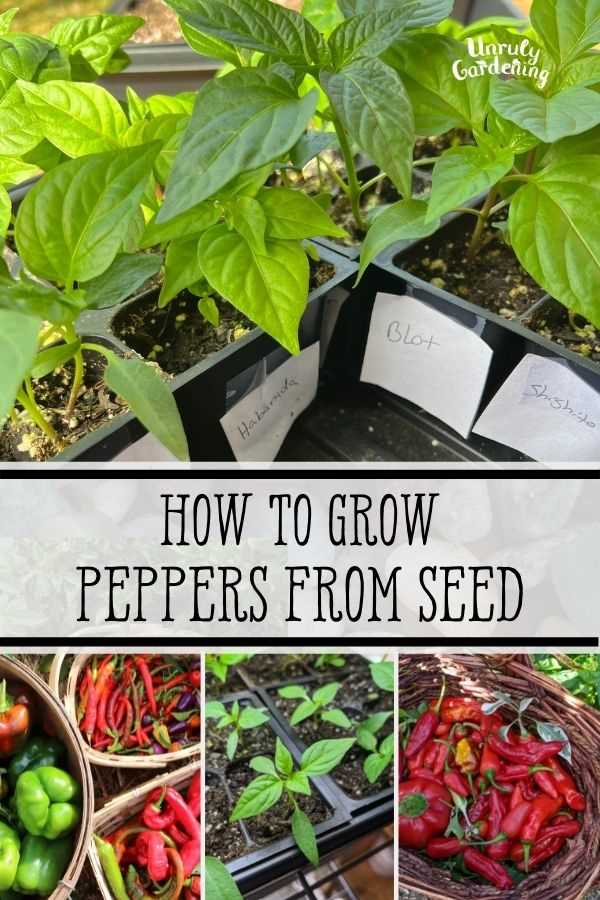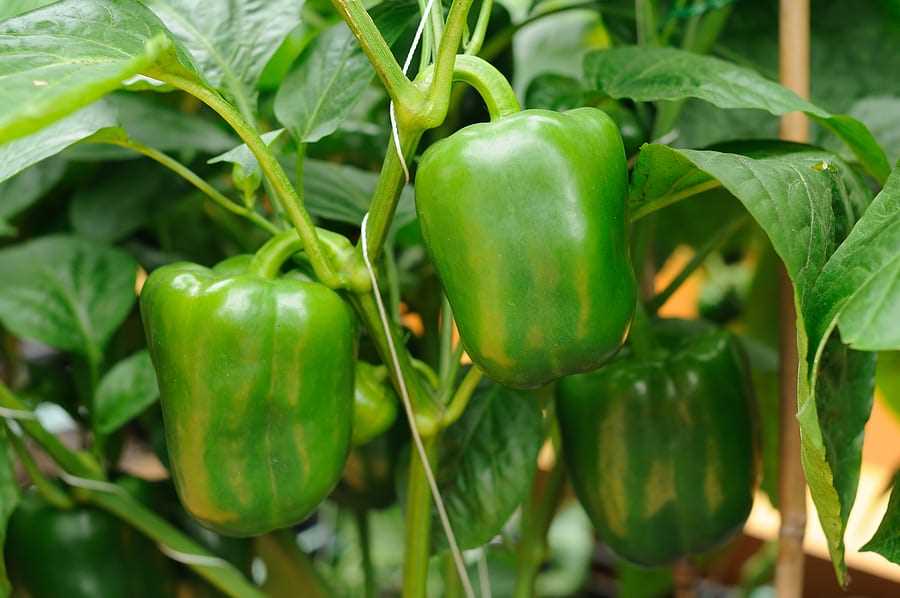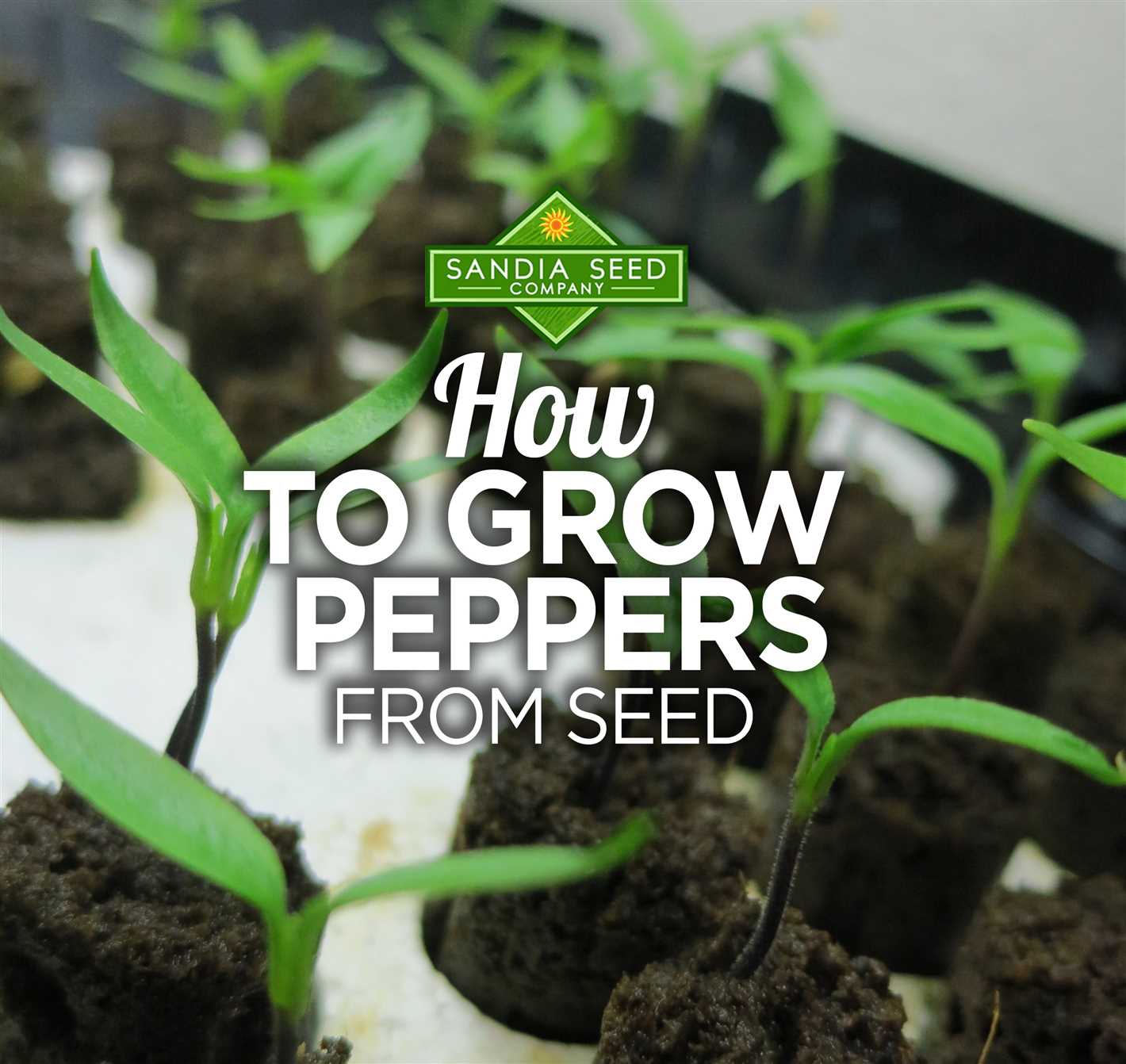- Choosing the right variety
- Preparing the soil for planting
- Sowing the seeds
- Choosing the right time
- Preparing the soil
- Sowing the seeds indoors
- Caring for the seeds
- Providing the right conditions for growth
- 1. Sunlight
- 2. Temperature
- 3. Soil
- 4. Watering
- 5. Fertilization
- 6. Mulching
- 7. Support
- 8. Pest and Disease Control
- Watering and fertilizing
- Watering
- Fertilizing
- Dealing with pests and diseases
- Pests
- Diseases
- Harvesting and Using the Peppers
- Harvesting Tips:
- Culinary Uses:
- “Question-Answer”
- What are some tips for growing bitter chilli peppers from seeds?
- What is the best time to start growing bitter chilli peppers from seeds?
- How long does it take for bitter chilli pepper seeds to germinate?
- Can I grow bitter chilli peppers from seeds in containers?
- What kind of soil should I use for growing bitter chilli peppers from seeds?
- How often should I water bitter chilli pepper seedlings?
- “Video” A Complete Guide to Starting Peppers Indoors: See Description for a Digital Table of Contents
Chilli peppers are a popular addition to many recipes, adding heat and flavor to dishes from around the world. If you’re a fan of spicy food, growing your own bitter chilli peppers is a great way to ensure a fresh and abundant supply. In this comprehensive guide, we’ll take you through the process of growing bitter chilli peppers from seeds in your vegetable garden.
First, it’s important to choose the right variety of bitter chilli pepper seeds for your garden. There are many different types available, each with its own unique flavor profile and level of heat. Some popular varieties include Carolina Reaper, Ghost Pepper, and Trinidad Scorpion. Consider the level of spice you prefer and the growing conditions in your area when selecting your seeds.
Once you have your seeds, you’ll need to start them indoors before transplanting them into your garden. This will give them a head start and increase their chances of success. Plant the seeds in a small container filled with seed starting mix, making sure to provide them with plenty of light, warmth, and moisture. It’s important to keep the soil consistently moist but not waterlogged, as this can lead to rot.
After a few weeks, your bitter chilli pepper seedlings should be ready to transplant into your vegetable garden. Choose a sunny spot with well-draining soil and gently remove the seedlings from their containers, being careful not to damage the delicate roots. Dig a hole in the garden and place the seedling in, making sure to cover the roots completely. Space the seedlings several inches apart to give them room to grow.
As your bitter chilli peppers grow, make sure to provide them with plenty of water and fertilizer to encourage healthy growth. They will also benefit from regular pruning to remove any dead or damaged leaves. Be patient, as it can take several months for your peppers to mature and ripen. Once they turn a vibrant shade of red or orange, they are ready to be harvested and enjoyed in your favorite spicy dishes!
In conclusion, growing bitter chilli peppers from seeds in your vegetable garden can be a rewarding and delicious endeavor. With the right variety of seeds, proper care, and a little bit of patience, you can enjoy a bountiful harvest of these fiery peppers. So why not give it a try and add a spicy kick to your homegrown meals?
Choosing the right variety
When it comes to growing bitter chilli peppers from seeds, it is important to choose the right variety for your garden. There are numerous varieties of bitter chilli peppers available, each with its own unique flavor, heat level, and growth characteristics.
Flavor:
Bitter chilli peppers can have a wide range of flavors, from mild and earthy to intense and fruity. Some varieties also have hints of citrus or smokiness. Consider the flavor profile you prefer and choose a variety that matches your taste preferences.
Heat Level:
The heat level of bitter chilli peppers is measured using the Scoville Scale. This scale ranges from 0 (no heat) to over 1 million (extremely hot). Decide how much heat you can handle and select a variety accordingly. Popular options include the Carolina Reaper, Ghost Pepper, and Habanero.
Growth Characteristics:
Consider the growth characteristics of the variety you choose. Some varieties are more compact and are suitable for container gardening, while others are taller and better suited for larger garden beds. Additionally, some varieties have a longer growing season, requiring more time and care.
Recommended Varieties:
- Bhut Jolokia (Ghost Pepper)
- Carolina Reaper
- Trinidad Moruga Scorpion
- Habanero
- Scotch Bonnet
These varieties are known for their intense heat and unique flavors and are commonly used in cooking and for making hot sauces.
Summary:
When choosing the right variety of bitter chilli peppers, consider the flavor, heat level, and growth characteristics that best suit your preferences and gardening needs. By selecting the right variety, you can ensure a successful and rewarding growing experience.
Preparing the soil for planting
Before planting bitter chilli peppers, it is important to prepare the soil to create the optimal growing conditions for the plants. Proper soil preparation will help the plants establish healthy roots and promote vigorous growth. Follow these steps to prepare the soil for planting:
- Choose a sunny location: Bitter chilli peppers thrive in full sun, so select a spot in your vegetable garden that receives at least 6 to 8 hours of direct sunlight per day.
- Clear the area: Remove any weeds, rocks, or debris from the planting area. These can compete with the chilli pepper plants for nutrients and water.
- Test the soil: Perform a soil test to determine its pH level and nutrient content. Bitter chilli peppers prefer a slightly acidic soil with a pH range of 6.2 to 6.8. Soil tests can also help identify any deficiencies or imbalances in nutrients that may need to be corrected.
- Amend the soil: Based on the results of the soil test, amend the soil as needed to create the optimal growing conditions for bitter chilli peppers. If the pH is too high, add some organic matter or sulfur to lower it. If certain nutrients are lacking, add appropriate fertilizers or compost to provide them.
- Turn the soil: Use a shovel or garden fork to loosen the soil to a depth of 12 to 15 inches (30 to 38 cm). This will improve drainage and create a loose, aerated soil structure that allows the roots to penetrate easily.
- Remove any remaining weeds: After turning the soil, check for any remaining weeds and remove them by hand or with a hoe. This will prevent them from competing with the chilli pepper plants for resources.
- Add organic matter: Incorporate organic matter, such as well-rotted compost or aged manure, into the soil. This will improve soil fertility, moisture retention, and overall soil structure.
- Level the soil: Smooth the soil surface with a rake to create a level planting area. This will make it easier to sow the seeds or transplant the seedlings.
By following these steps to prepare the soil, you will provide the optimum growing conditions for bitter chilli peppers, setting the stage for a successful and productive harvest.
Sowing the seeds
Choosing the right time
Before sowing the chilli pepper seeds, it’s important to choose the right time to start the process. Chilli peppers thrive in warm climates, so it’s best to sow the seeds indoors in early spring, around 6-8 weeks before the last frost date. This will give the seeds enough time to germinate and develop into seedlings before being transplanted to the outdoor vegetable garden.
Preparing the soil

Chilli pepper plants prefer well-drained soil that is rich in organic matter. Before sowing the seeds, prepare the soil by loosening it with a garden fork or tiller. Remove any weeds or debris and mix in compost or well-rotted manure to improve fertility.
Sowing the seeds indoors
- Fill a seed tray or small pots with seed compost, leaving about 1 inch of space at the top.
- Moisten the compost lightly with water.
- Sow the chilli pepper seeds on the surface of the compost, spacing them about 1 inch apart.
- Lightly press the seeds into the compost, but do not bury them too deep.
- Cover the tray or pots with a clear plastic lid or plastic wrap to create a greenhouse-like environment.
- Place the tray or pots in a warm location with a temperature of around 75-80°F (24-27°C).
Caring for the seeds
Once the seeds are sown, it’s important to provide them with the right conditions for germination. Here are a few key tips:
- Keep the compost moist, but not waterlogged.
- Avoid temperature fluctuations by keeping the seeds in a warm location.
- Check the tray or pots daily and remove the plastic cover once the seeds have germinated.
- Place the seedlings under grow lights or near a sunny window to ensure they get enough light.
By following these steps and providing proper care, your chilli pepper seeds will germinate and grow into healthy seedlings ready for transplanting to the outdoor vegetable garden.
Providing the right conditions for growth

Creating the right conditions for growing bitter chilli peppers is crucial to ensure their healthy development. Here are some important factors to consider:
1. Sunlight
Bitter chilli peppers thrive in full sunlight. It is important to choose a location for your vegetable garden that receives at least 6-8 hours of direct sunlight each day. This will ensure optimal growth and abundant fruit production.
2. Temperature

Bitter chilli peppers prefer warm to hot temperatures for optimal growth. The ideal temperature range for growing chilli peppers is between 70-85°F (21-29°C). Temperatures below 60°F (16°C) can slow down the growth and development of the plants. Therefore, it is recommended to start planting your seeds in late spring or early summer, when the outdoor temperature is consistently above 60°F (16°C).
3. Soil
Well-draining soil with a pH level between 6.0 and 7.0 is ideal for growing bitter chilli peppers. Ensure the soil is rich in organic matter and has good drainage to prevent waterlogging, which can lead to root rot. Adding compost or aged manure to the soil before planting will provide essential nutrients and improve its overall quality.
4. Watering
Proper watering is essential for the healthy growth of bitter chilli peppers. The soil should be kept consistently moist but not waterlogged. Water the plants deeply and thoroughly, allowing the top inch of soil to dry out between watering sessions. Avoid overwatering, as it can cause root rot and other fungal diseases.
5. Fertilization
Regular fertilization is important to provide the necessary nutrients for the plants’ growth. Use a balanced fertilizer with equal proportions of nitrogen, phosphorus, and potassium. Apply the fertilizer according to the package instructions, usually every 4-6 weeks, throughout the growing season. Avoid over-fertilizing, as it can lead to excessive foliage growth at the expense of fruit development.
6. Mulching
Applying a layer of organic mulch around the base of the plants can help retain moisture, suppress weed growth, and regulate soil temperature. Use organic materials such as straw, wood chips, or shredded leaves as mulch. Keep the mulch at a distance from the plant stems to prevent rotting.
7. Support
As the bitter chilli pepper plants grow taller and start bearing fruit, they may need support to prevent bending or breaking under their weight. Install stakes or cages around the plants to provide support and keep the stems upright. This will also facilitate better air circulation and sunlight penetration, reducing the risk of disease.
8. Pest and Disease Control
Regularly inspect the plants for pests, such as aphids, spider mites, or caterpillars, and take appropriate measures to control them. There are various organic insecticides and pest control methods available for this purpose. Additionally, keep the garden area clean and free from weeds, as they can harbor pests and diseases.
By providing the right conditions for growth, you can ensure that your bitter chilli pepper plants thrive and produce a bountiful harvest of flavorful and spicy peppers.
Watering and fertilizing
Watering
Proper watering is crucial for the successful growth of bitter chilli peppers. These plants require consistent and adequate moisture to thrive, but overwatering can lead to root rot and other issues. Follow these guidelines to ensure proper watering:
- Monitor the soil moisture regularly. Stick your finger into the soil to check the moisture level. If the top inch of soil feels dry, it’s time to water.
- Water deeply and thoroughly. Use a watering can or a hose with a gentle flow to saturate the soil around the base of the plants. Avoid splashing water on the leaves to prevent diseases.
- Water in the morning. It allows the plant to absorb the moisture before the heat of the day and reduces the risk of fungal diseases.
- Provide consistent moisture. Avoid allowing the soil to completely dry out between waterings, as it can stress the plants. However, avoid overwatering, as it can drown the plant.
- Consider using a drip irrigation system or soaker hoses for a more efficient and targeted watering method.
Fertilizing
Bitter chilli peppers are heavy feeders and require regular fertilization to ensure optimal growth and fruit production. Follow these tips for fertilizing your plants:
- Apply a balanced fertilizer with an equal ratio of nitrogen (N), phosphorus (P), and potassium (K) when planting your chilli pepper seeds or transplanting seedlings.
- Side-dress the plants with compost or well-rotted manure to provide additional nutrients throughout the growing season.
- Use a water-soluble fertilizer formulated specifically for peppers or vegetables, following the package instructions for application rates and frequencies.
- Fertilize every 2-3 weeks during the growing season.
- Avoid over-fertilizing, as it can cause nutrient burn and negatively affect the plant’s health.
By ensuring proper watering and regular fertilization, you can provide your bitter chilli peppers with the essential nutrients they need for healthy growth and abundant yields.
Dealing with pests and diseases
Growing bitter chilli peppers from seeds in the vegetable garden can be a rewarding experience, but it is important to be prepared to deal with pests and diseases that can affect your plants. Here are some common pests and diseases that can be a problem when growing peppers, and how to deal with them:
Pests

- Aphids: These small insects can suck the sap from the leaves of your pepper plants, causing them to wilt and die. To control aphids, you can spray your plants with a mixture of water and dish soap. Alternatively, you can introduce ladybugs, which are natural predators of aphids, into your garden.
- Cutworms: These caterpillars can cut through the stems of young pepper plants, causing them to topple over. To protect your plants from cutworms, you can place collars made from cardboard or aluminum foil around the base of the plants.
- Spider mites: These tiny pests can cause discoloration and webbing on the leaves of your pepper plants. To control spider mites, you can spray your plants with a mixture of water and neem oil.
- Slugs and snails: These slimy creatures can eat holes in the leaves of your pepper plants. To control slugs and snails, you can scatter crushed eggshells or diatomaceous earth around the base of your plants.
- Thrips: These small insects can suck the sap from the buds and flowers of your pepper plants, causing them to deform and drop off. To control thrips, you can spray your plants with a mixture of water and insecticidal soap.
Diseases
- Fungal diseases: Pepper plants can be susceptible to various fungal diseases, such as powdery mildew and damping off. To prevent fungal diseases, it is important to provide good air circulation around your plants and avoid over-watering. If your plants do become infected, you can treat them with a fungicide.
- Bacterial diseases: Pepper plants can also be affected by bacterial diseases, such as bacterial spot. These diseases can cause spots or lesions on the leaves and fruits of your plants. To prevent bacterial diseases, it is important to avoid overhead watering and to rotate your crops each year.
- Viral diseases: Pepper plants can be infected with various viral diseases, such as tobacco mosaic virus. These diseases can cause stunted growth and mottling on the leaves of your plants. Unfortunately, there is no cure for viral diseases. It is important to practice good hygiene and remove and destroy infected plants to prevent the spread of the virus.
By being aware of common pests and diseases that can affect bitter chilli pepper plants and taking appropriate measures to prevent and control them, you can increase your chances of a successful harvest.
Harvesting and Using the Peppers
Once your bitter chili peppers have ripened to their full color, it’s time to harvest them. You can either pluck the peppers from the plant by hand or use scissors to cut them off at the stem. Be sure to wear gloves when handling the peppers, as their oils can irritate the skin and eyes.
Harvesting Tips:
- Harvest the peppers when they have reached their desired level of spiciness and flavor.
- Check the peppers regularly as they ripen, as some varieties change colors when fully mature.
- Avoid pulling on the peppers forcefully, as this can damage the plant.
Once harvested, the bitter chili peppers have a variety of uses in the kitchen. Here are a few ideas:
Culinary Uses:
- Add heat to your favorite dishes by slicing or dicing the peppers and incorporating them into salsas, stir-fries, and curries.
- Dry the peppers to create chili flakes or powder, which can be used as a spice to add a kick to any recipe.
- Create your own hot sauce by blending the peppers with vinegar, garlic, and other desired ingredients.
However, it’s important to remember that bitter chili peppers are extremely hot and can be overpowering if used in excess. Start with small amounts and adjust to taste. Always exercise caution when handling and consuming these fiery peppers.
| Pepper Variety | Scoville Heat Units (SHU) |
|---|---|
| Habanero | 100,000 – 350,000 |
| Scotch Bonnet | 100,000 – 350,000 |
| Ghost Pepper | 855,000 – 1,041,427 |
| Carolina Reaper | 1,400,000 – 2,200,000 |
Remember to store harvested peppers in a cool, dry place to ensure their longevity. Enjoy experimenting with these spicy gems and discovering your favorite ways to incorporate them into your meals!
“Question-Answer”
What are some tips for growing bitter chilli peppers from seeds?
Some tips for growing bitter chilli peppers from seeds include starting the seeds indoors, providing them with adequate light and warmth, and transplanting them outdoors after the last frost.
What is the best time to start growing bitter chilli peppers from seeds?
The best time to start growing bitter chilli peppers from seeds is about 8-10 weeks before the last expected frost date in your area.
How long does it take for bitter chilli pepper seeds to germinate?
Bitter chilli pepper seeds usually take about 7-14 days to germinate, but it can vary depending on the variety and growing conditions.
Can I grow bitter chilli peppers from seeds in containers?
Yes, you can grow bitter chilli peppers from seeds in containers. Just make sure the containers have proper drainage and are large enough to accommodate the plant’s root system.
What kind of soil should I use for growing bitter chilli peppers from seeds?
It is best to use a well-draining and fertile soil mix for growing bitter chilli peppers from seeds. You can make your own mix using equal parts of compost, garden soil, and perlite or vermiculite.
How often should I water bitter chilli pepper seedlings?
Bitter chilli pepper seedlings should be watered regularly, keeping the soil consistently moist but not waterlogged. It is important to water them from the bottom to avoid wetting the leaves, which can lead to fungal diseases.







